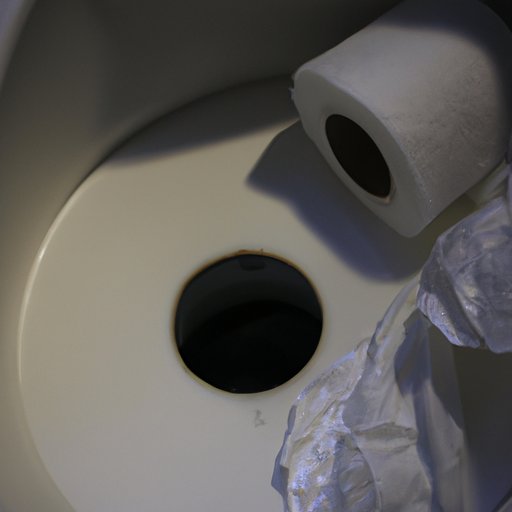Introduction
Flushing tissues down the toilet seems like a simple solution to getting rid of them. However, this daily routine has become a major problem for many households, and it’s not just about how tissues clog toilets. It’s also about the adverse effects they have on the environment and plumbing systems.
In this article, we will discuss the risks and dangers of flushing tissues down the toilet. We will also provide you with a comprehensive guide on what you should and shouldn’t flush down the toilet, and how to take care of your plumbing system.
The Risks of Flushing Tissues: What You Need to Know
Tissues may seem harmless because they are made of paper, but they can cause significant damage to the environment and plumbing systems. Tissues are typically made with materials that do not easily dissolve in water, such as wood pulp. When tissues are flushed down the toilet, they don’t break down as quickly as toilet paper, which is specifically designed to break down when exposed to water.
The slow break-down time of tissues in water makes them a significant threat to the environment. Tissues that make it through sewage treatment plants end up in oceans, rivers, and other waterways, where they can harm marine life. Marine animals, such as turtles, can mistake the tissues for food, leading to ingestion and possible death.
But, that’s not all. Flushing tissues can also cause significant damage to your home’s plumbing. Tissues can quickly accumulate in your pipes and cause blockages. These blockages can lead to costly repairs for homeowners and cause problems for the municipal sewer system.
The Do’s and Don’ts of Flushing Tissues: A Comprehensive Guide
The rule of thumb here is that you should only flush toilet paper down the toilet. Anything else, including tissues, should be disposed of in the trash can. In fact, there are several things that shouldn’t be flushed down the toilet:
- Facial tissues or paper towels
- Cotton balls or swabs
- Feminine hygiene products
- Baby wipes or diapers
- Medications or vitamins
If you’re wondering what to do with used tissues, there is a proper way to dispose of them. After using a tissue, put it in a trash can and cover it with the trash bag. This way, the tissue won’t mix with other trash or become a hazard to the environment.
Taking care of your plumbing system is essential, and it’s not just about what goes down the toilet. It’s also important to use drain covers to prevent hair and other debris from clogging your pipes. You can use hot water and vinegar to help dissolve clogs and keep your pipes clear. Regularly scheduling septic tank inspections and maintenance will help you detect and avoid potential problems.
The Surprising Ways Tissues Can Clog Your Pipes and Damage Your Plumbing
The most obvious way tissues can clog your pipes is when they’re flushed down the toilet. Tissues can quickly accumulate in pipes and cause blockages, leading to backups and possible damage to your plumbing system.
In addition to blocking pipes, tissue papers can also create a nuisance for your plumbing system by sticking to the interior of pipes. Over time, this can create layers of blockages that make it difficult for water to flow through your pipes. The result is a slow drainage system that takes forever to remove waste from your home or business.
Tissues can cause significant damage to your plumbing system, but they also pose a threat to the environment. Sewer backups caused by clogs can lead to raw sewage spilling into water bodies and disrupting aquatic life. Over time, tissue papers can accumulate in water treatment plants and reduce their efficiency, resulting in increased energy consumption, higher water bills, and reduced lifespan of equipment.
The Truth About Flushing Tissues: What Your Plumber Wants You to Know
According to professional plumbers, flushing tissues down the toilet is a significant risk factor for homeowners. Tissues that are flushed down the toilet don’t dissolve like toilet paper. Instead, they remain whole and can quickly accumulate in your pipes, forming a thick blockage that prevents water from flowing freely.
The cost of repairing plumbing issues that result from flushing tissues down the toilet can be expensive, making prevention critical. Homeowners should be mindful of what they’re flushing and how they dispose of used tissues. Regular septic tank maintenance can also help avoid issues related to clogs in the plumbing system.
Think Before You Flush: The Dangers of Tissues in Your Plumbing System
Tissues that are flushed down the toilet end up in the municipal sewer system, where they can cause significant problems. When tissues accumulate, they create a web of blockages that can damage the entire sewer system. Over time, untreated sewage can cause environmental damage, compromise public utilities, and damage property.
As responsible citizens, it’s our duty to protect the environment and keep our plumbing systems healthy. One way to do this is by being mindful of what goes down the toilet. Remember, only flush toilet paper down the toilet, and everything else should be thrown in the trash.
Conclusion
In conclusion, flushing tissues down the toilet can lead to severe problems for homeowners, the environment, and municipal sewer systems. You can avoid these problems and save yourself a lot of money by being mindful of what you flush down the toilet and how you handle used tissues.
Remember to dispose of tissues properly by throwing them in the trash can rather than flushing them. Regular septic tank maintenance can also help detect and prevent potential plumbing problems. By being responsible, we can all contribute to protecting the environment and keeping our plumbing systems healthy.
So, think before you flush!
Call to action: Help protect our environment and keep our plumbing systems healthy by avoiding flushing tissues down the toilet.
